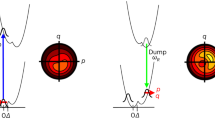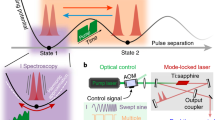Abstract
Coherent light sources can be used to manipulate the outcome of light–matter interactions by exploiting interference phenomena in the time and frequency domain. A powerful tool in this emerging field of ‘quantum control’1,2,3,4,5,6 is the adaptive shaping of femtosecond laser pulses7,8,9,10, resulting, for instance, in selective molecular excitation. The basis of this method is that the quantum system under investigation itself guides an automated search, via iteration loops, for coherent light fields best suited for achieving a control task designed by the experimenter11. The method is therefore ideal for the control of complex experiments7,12,13,14,15,16,17,18,19,20. To date, all demonstrations of this technique on molecular systems have focused on controlling the outcome of photo-induced reactions in identical molecules, and little attention has been paid to selectively controlling mixtures of different molecules. Here we report simultaneous but selective multi-photon excitation of two distinct electronically and structurally complex dye molecules in solution. Despite the failure of single parameter variations (wavelength, intensity, or linear chirp control), adaptive femtosecond pulse shaping can reveal complex laser fields to achieve chemically selective molecular excitation. Furthermore, our results prove that phase coherences of the solute molecule persist for more than 100 fs in the solvent environment.
This is a preview of subscription content, access via your institution
Access options
Subscribe to this journal
Receive 51 print issues and online access
$199.00 per year
only $3.90 per issue
Buy this article
- Purchase on Springer Link
- Instant access to full article PDF
Prices may be subject to local taxes which are calculated during checkout




Similar content being viewed by others
References
Warren, W. S., Rabitz, H. & Dahleh, M. Coherent control of quantum dynamics—The dream is alive. Science 259, 1581–1589 (1993).
Rice, S. A. & Zhao, M. Optical Control of Molecular Dynamics (Wiley, New York, 2000).
Rabitz, H., de Vivie-Riedle, R., Motzkus, M. & Kompa, K. Whither the future of controlling quantum phenomena? Science 288, 824–828 (2000).
Shapiro, M. & Brumer, P. Coherent control of atomic, molecular, and electronic processes. Adv. Atom. Mol. Opt. Phys. 42, 287–345 (2000).
Tannor, D. J. & Rice, S. A. Control of selectivity of chemical reaction via control of wavepacket evolution. J. Chem. Phys. 83, 5013–5018 (1985).
Brixner, T., Damrauer, N. H. & Gerber, G. Femtosecond quantum control. Adv. Atom. Mol. Opt. Phys. 46, 1–54 (2001).
Bardeen, C. J. et al. Feedback quantum control of molecular electronic population transfer. Chem. Phys. Lett. 280, 151–158 (1997).
Baumert, T., Brixner, T., Seyfried, V., Strehle, M. & Gerber, G. Femtosecond pulse shaping by an evolutionary algorithm with feedback. Appl. Phys. B 65, 779–782 (1997).
Yelin, D., Meshulach, D. & Silberberg, Y. Adaptive femtosecond pulse compression. Opt. Lett. 22, 1793–1795 (1997).
Brixner, T., Strehle, M. & Gerber, G. Feedback-controlled optimization of amplified femtosecond laser pulses. Appl. Phys. B 68, 281–284 (1999).
Judson, R. S. & Rabitz, H. Teaching lasers to control molecules. Phys. Rev. Lett. 68, 1500–1503 (1992).
Assion, A. et al. Control of chemical reactions by feedback-optimized phase-shaped femtosecond laser pulses. Science 282, 919–922 (1998).
Meshulach, D. & Silberberg, Y. Coherent quantum control of two-photon transitions by a femtosecond laser pulse. Nature 396, 239–242 (1998).
Weinacht, T. C., White, J. & Bucksbaum, P. H. Toward strong field mode-selective chemistry. J. Phys. Chem. A 103, 10166–10168 (1999).
Weinacht, T. C., Ahn, J. & Bucksbaum, P. H. Controlling the shape of a quantum wavefunction. Nature 397, 233–235 (1999).
Hornung, T., Meier, R. & Motzkus, M. Optimal control of molecular states in a learning loop with a parameterization in frequency and time domain. Chem. Phys. Lett. 326, 445–453 (2000).
Kunde, J. et al. Adaptive feedback control of ultrafast semiconductor nonlinearities. Appl. Phys. Lett. 77, 924–926 (2000).
Bartels, R. et al. Shaped-pulse optimization of coherent emission of high-harmonic soft X-rays. Nature 406, 164–166 (2000).
Levis, R. J., Menkir, G. M. & Rabitz, H. Selective bond dissociation and rearrangement with optimally tailored, strong-field laser pulses. Science 292, 709–713 (2001).
Brixner, T., Kiefer, B. & Gerber, G. Problem complexity in femtosecond quantum control. Chem. Phys. 267, 241–246 (2001).
Weiner, A. M. Femtosecond pulse shaping using spatial light modulators. Rev. Sci. Instrum. 71, 1929–1960 (2000).
Damrauer, N. H., Boussie, T. R., Devenney, M. & McCusker, J. K. Effects of intraligand electron delocalization, steric tuning, and excited-state vibronic coupling on the photophysics of aryl-substituted bipyridyl complexes of Ru(II). J. Am. Chem. Soc. 119, 8253–8268 (1997).
Damrauer, N. H. & McCusker, J. K. Ultrafast dynamics in the metal-to-ligand charge transfer excited-state evolution of [Ru(4,4′-diphenyl-2,2′-bipyridine)3]2+. J. Phys. Chem. A 103, 8440–8446 (1999).
Meyer, M., Mialocq, J. C. & Perly, B. Photoinduced intramolecular charge transfer and trans-cis isomerization of the DCM styrene dye. Picosecond and nanosecond laser spectroscopy, high-performance liquid chromatography, and nuclear magnetic resonance studies. J. Phys. Chem. 94, 98–104 (1990).
Assion, A., Baumert, T., Helbing, J., Seyfried, V. & Gerber, G. Coherent control by a single phase shaped femtosecond laser pulse. Chem. Phys. Lett. 259, 488–494 (1996).
Broers, B., van Linden van den Heuvell, H. B. & Noordam, L. D. Efficient population transfer in a three-level ladder system by frequency-swept ultrashort laser pulses. Phys. Rev. Lett. 69, 2062–2065 (1992).
Bardeen, C. J., Wang, Q. & Shank, C. V. Selective excitation of vibrational wave-packet motion using chirped pulses. Phys. Rev. Lett. 75, 3410–3413 (1995).
Cerullo, G., Bardeen, C. J., Wang, Q. & Shank, C. V. High-power femtosecond chirped pulse excitation of molecules in solution. Chem. Phys. Lett. 262, 362–368 (1996).
Meshulach, D. & Silberberg, Y. Coherent quantum control of multiphoton transitions by shaped ultrashort optical pulses. Phys. Rev. A 60, 1287–1292 (1999).
Lalović, D., Davidović, D. M. & Bijedić, N. Quantum mechanics in terms of non-negative smoothed Wigner functions. Phys. Rev. A 46, 1206–1212 (1992).
Acknowledgements
This work was supported by the European Coherent Control Network (COCOMO) and the Fonds der Chemischen Industrie. N.D. thanks the Alexander von Humboldt-Stiftung for a postdoctoral fellowship.
Author information
Authors and Affiliations
Corresponding author
Rights and permissions
About this article
Cite this article
Brixner, T., Damrauer, N., Niklaus, P. et al. Photoselective adaptive femtosecond quantum control in the liquid phase. Nature 414, 57–60 (2001). https://doi.org/10.1038/35102037
Received:
Accepted:
Issue Date:
DOI: https://doi.org/10.1038/35102037
This article is cited by
-
Multi-pulse laser-induced bubble formation and nanoparticle aggregation using MoS2 nanoparticles
Scientific Reports (2020)
-
Coherent control of an opsin in living brain tissue
Nature Physics (2017)
-
Photonic reagents for concentration measurement of flu-orescent proteins with overlapping spectra
Scientific Reports (2016)
-
Rapid and robust control of single quantum dots
Light: Science & Applications (2016)
-
Discriminating Bio-aerosols from Non-Bio-aerosols in Real-Time by Pump-Probe Spectroscopy
Scientific Reports (2016)
Comments
By submitting a comment you agree to abide by our Terms and Community Guidelines. If you find something abusive or that does not comply with our terms or guidelines please flag it as inappropriate.



